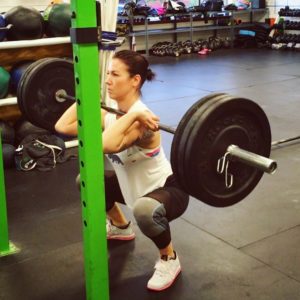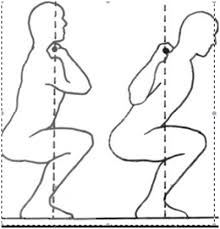From July until the end of September, CrossFit Prototype will be posting a blog per week as part of our Accessory Series. These blog posts will review 1 of the 13 CFP foundational movements (Air Squat, Back Squat, Front Squat, Deadlift, Kettlebell Swing, Pull-Up, Overhead Press, Push Press, Push Jerk, Clean, Snatch & Rowing) and provide tips on accessory exercises to help improve that area of your CrossFit game.
By Joe Black (CF-L2, USAW-L1SP)
 What do cleans, thrusters and wall balls have in common?
What do cleans, thrusters and wall balls have in common?
They rely on the front squat as the base of their movement. In order to improve your movement efficiency and strength with these movements, it is a great idea to start with the front squat.
If you were looking at your body from the side, the frontal plane is the intersection of your body from your head to your foot. When you front squat, the bar rests on your shoulders, which are in front of the frontal plane. This requires you to have a more upright torso to find your balance.
With a back squat, the bar rests on your shoulder blades and traps, which is in back of the frontal plane. This allows one to hinge slightly at the hip, putting their torso at an angle that allows one to feel balanced.

Front squat bar placement on the left, back squat bar placement on the right.
Let’s review how to properly front squat, look at some great mobility drills for your front rack (where the bar is placed) and discuss accessory exercises to help improve your front squat.
How to Front Squat
- Take the bar from a rack with a full grip (if able) that places your hands outside of your shoulders.
- Rest the bar on your shoulders (deltoids) and lift your shoulders up to create a solid “rack” or “shelf” for the bar to sit on.
- Lift your elbows so that your triceps are parallel to the ground.
- Take a deep belly breath and brace your torso like you were preparing for a punch.
- Staying balanced through your feet, start your squat by pushing your knees out and sitting your hips down and back.
- Fight throughout the movement to keep your elbows in the same position as you started – this will help you maintain an upright torso.
- Reach depth and push hard into the floor to rise back up. It may be helpful to think about letting the elbow lead you up.
Front Squat Mobility
I really enjoy this mobility advice from Dave Tilley, as seen on Barbell Shrugged (an awesome podcast I highly recommened!). It helps you diagnose the area or areas you need to work on the most and provides you with simple mobility drills to loosen up prior to front squatting.
These drills are:
- Roll out your forearms with a lacrosse ball to improve wrist extension.
- Roll out your triceps with a lacrosse ball to improve elbow flexion.
- Stretch your back (lats) with a PVC pipe and bench to improve shoulder flexion.
- Stretch your shoulders with a PVC pipe to improve external shoulder rotation.
Additionally, this video from T-Nation provides you with great thoracic spine (upper-back) mobility drills to prep for front squatting.
Front Squat Accessory Exercises
Here are a handful of accessory exercises which will help your front squat:
Front Rack Step-Ups
This is a great exercise to develop rigidness in your front rack while working one of the primary movers of the front squat, your quads. Use a box that is slightly above knee height. Start with the bar in the front rack position and one foot on the box. Step up onto the box, driving through your foot and ensuring that your hip and you knee are in a straight line (extension) before the other foot steps onto the box. Step down, in control and repeat. Try 2-3 sets of 8-12 reps.
Dumbbell Rows
Rows help build a strong upper back. A strong upper back will help you hold your front rack position and prevent your elbows from dropping. Start with your left hand and left knee on a bench, with your right foot on the ground for support and your right hand holding a dumbbell. With the dumbbell directly underneath you, pull up and back. Slowly lower the dumbbell, working full range of motion. Work these in for 2-3 sets of 8-12 reps per side.
Flat Back Hip Extensions
Flat back hip extensions target the muscles of the lower back, butt and spine. These muscles work to help you maintain an upright torso when you front squat. Set up a back extensions or GHD machine so that your hips rest on the pads, allowing you to hinge at the hip. Keeping your back in extension (which means that you are actively holding the natural curve of your lower spine), rise up by pushing your hips into the pads and squeezing your butt for 1-2 seconds at the top of the movement. Lower under control, maintaining back extension the entire time. Start with 2 sets of 10-12 reps and add weight over time.
Tempo Front Squats
Nothing will provide you with better mobility in the long term than loading the movement you are working on and doing your best to fight for ideal positions throughout the lift. Tempo front squats will help create awareness of where your body breaks down during the movement and will allow you to move with control through these areas to increase your mobility. Tempo front squats would be performed with a controlled squat down (3-5 seconds), a pause in the bottom (1-5 seconds) and a controlled rise that is quicker than your squat down. In some cases, you might even want to slow down the ascent. Test these with an empty barbell first and do 2-3 sets of 3-5 reps, using a weight that allows you to move well.
